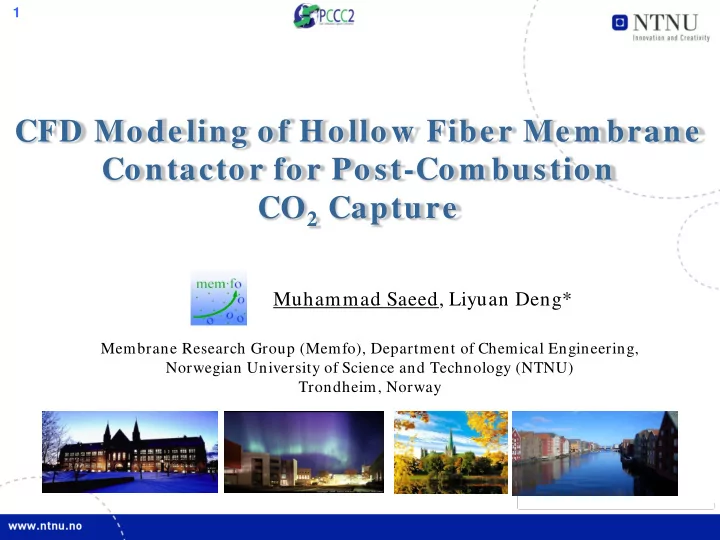

1 CFD Modeling of Hollow Fiber Mem brane Contactor for Post-Com bustion CO 2 Capture Muhammad Saeed, Liyuan Deng* Membrane Research Group (Memfo), Department of Chemical Engineering, Norwegian University of Science and Technology (NTNU) Trondheim, Norway
2 Outline Introduction Mass Transfer in a gas/ liquid membrane contactor Development of CFD model Results and discussion Characterization of Liquid/ gas film resistance Influence of membrane to overall mass transfer Influence of chemical reaction to overall mass transfer Conclusions
3 Introduction Mem brane contactor; a hybrid technology Com pared to absorption colum ns Larger sp. surface area, linear scale-up, modular design, flexible operation Contractors Sp surface area Reference (m 2 / m 3 ) Free dispersion column 1-10 Reed et al. (1995) Mechanically agitated 50-150 Westerterp et al. (1984) column Packed column 100-800 Reed et al. (1995) Amine Membrane contactor 1500-3000 Kumar et al. (2002) Absorption Unit
4 Introduction Mem brane contactor for flue gas treatm ent High and non dispersive contact offers efficient mass transfer Highly reactive Carbonic anhydrase (CA) and mimic CA with reaction rate 4000 times faster than MEA to account for low mass transfer driving force Mimic Carbonic Anhydrase Molecular structure Carbonic Anhydrase Molecular structure Hydration rate of CO2 by various absorbents . Aines R. H Lawrence Livermore National Laboratory
5 Scope This work Dimensional Data CFD model of a membrane contactor with physical and chemical absorption by using Multi physics COMSOL Physio chemical Model Reaction kinetics Carbonic anhydrase (CA) and Properties mimic CA for reactive absorption of CO2 Mass transfer through a micro Conc porous, hydrophobic Effect of each /velocity parameter membrane profiles Developed model to suggest an optimal set of parameters for designing operations of a membrane contactor. Optimal solution
6 Mass Transfer in Mem brane Contactor Overall mass transfer in a membrane contactor is analogues to heat transfer and can be exemplified by resistance in series model. 1 1 1 1 = + + K k k k ov l m g ∂ ∂ ∂ Gas Film C 1 C = A A u D r . ∂ ∂ Ag z r r r ∂ ∂ ∂ Liquid C 1 C = − A A v D r . R ∂ ∂ AL A Film z r r r Membrane CO 2 concentration profile in a membrane contactor adapted from Journal of Membrane Science 380 (2011) 21– 33
7 Membrane Model developm ent Shell/Gas Tube/Liquid Assum ptions Regular and uniform pores Hydrophobic membrane First order reaction between CO2 and catalyst. Z r Velocity profile in gas/ liquid phase Model Basis Velocities are adjusted to maintain a laminar regime Flue gas containing 10% CO2 at 1 bar and 25 o C. Carbonic Anhydrase (CA) and mimic CA catalyst to promote the absorption in liquid Longitudinal hollow fiber membrane contactor AlChe Journal 1986,32,11 1910-16
8 Model development (cont…) Basis for model geometry In this work Finite Element Param eter Sym bol Value Method is used for calculations. Length L 100mm Radius of membrane R 1 1 mm Membrane Radius of shell R 2 6mm Liquid Bulk Porosity P or 0.7 Tortuosity T or 2 Gas Fiilm Conc. in gas phase C o 10 % Shell/gas Membrane Finite element with physics controlled size Literature Value Source Diffusivity in Shell 1.5 x 10 -5 m 2 / S Reid, R. C.; Prausnitz, 1986 Tube/Liquid 1.92 x 10 -9 m 2 / S Diffusivity in water Chem. Eng. Comm., 1996, 144,113-158 Partition coefficient 1.205 x 10 -2 J. Chern. Eng. Data, 1988, 33, 29-34, Reaction rate of MEA 5920 (1/ s) Chem Eng. Sci. 2007,39,207-25
9 Results and Discussion Physical absorption of CO2 in liquid Liquid/Tube Gas/Shell Concentration profile of CO 2 in tube/Liquid Radial concentration profile in Liquid phase bulk concentration along the liquid phase length of contactor. Liquid velocity changing from 1e-5 to 1 m/s Appreciable effect on liquid loading.
10 Results and Discussion Physical absorption of CO2 in liquid Appreciable effect on liquid loading. However, no significant effect on gas phase
11 Results and Discussion Characterization of Gas film resistance Membrane GAS Liquid Radial concentration profile in gas Gas phase concentration along the length of contactor Concentration profile of CO 2 in shell and tube Investigated gas velocity: 1e-4 to 10 m/ s Appreciable effect of gas velocity at interfacial concentration shows that mass transfer limitation has now moved from liquid film to gas film/ membrane.
12 Results and Discussion Influence of porosity Physical absorption Chemisorption Gas phase radial concentration. porosity Gas phase radial concentration. porosity Porosity of membrane varied from 0.1 to 1. Membrane resistance has significant contribution to mass transfer in chemical absorption .
13 Results and Discussion Influence of membrane thickness Thickness of membrane was varied between 1 mm and 1e-4 mm. Thickness of membrane does have a significant effect on mass transfer but developing a self supported membrane of 1e-4 mm is challenging. Gas phase radial concentration at varies membrane thickness
14 Results and Discussion Influence of Reaction Gas phase radial concentration at various reaction rates Gas phase axial concentration at various reaction rates Reaction rate varied 10, 100 and 1000 times that of MEA. With increase in reaction rate, a significant increase in efficiency is observed
15 Conclusions For Physical absorption, liquid film resistance is the limiting factor to mass transfer. For Chemisorption mass transfer resistance shifts to membrane and gas film. Membrane porosity and thickness contributes significantly to mass transfer in chemical absorption. This work is a guideline to design a membrane contactor operating with and without chemical reaction.
16 Validation
17 Thank you for your attention! Special thanks to: Dr Ardi Hartono Mr Hassan Ali
Recommend
More recommend